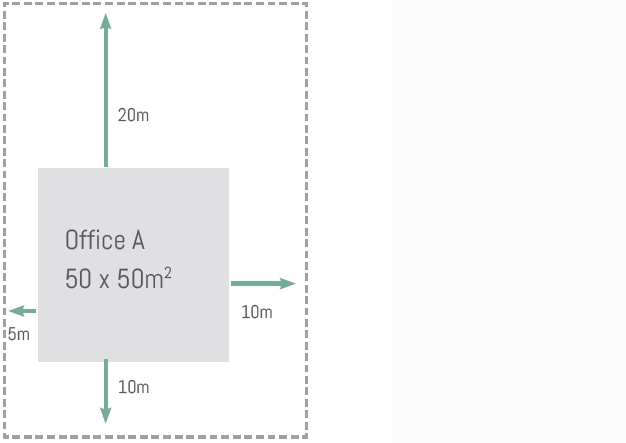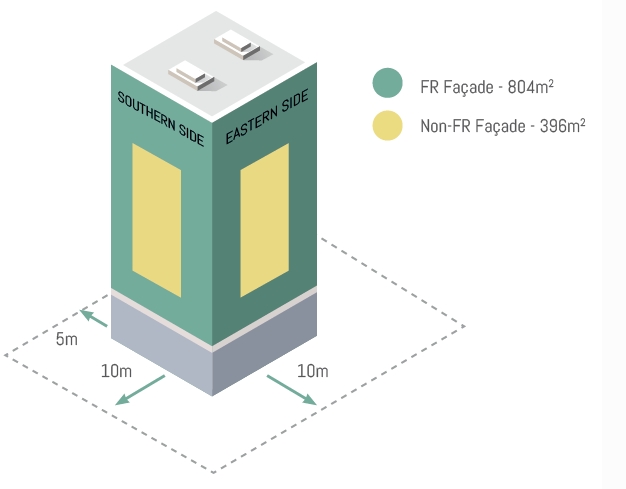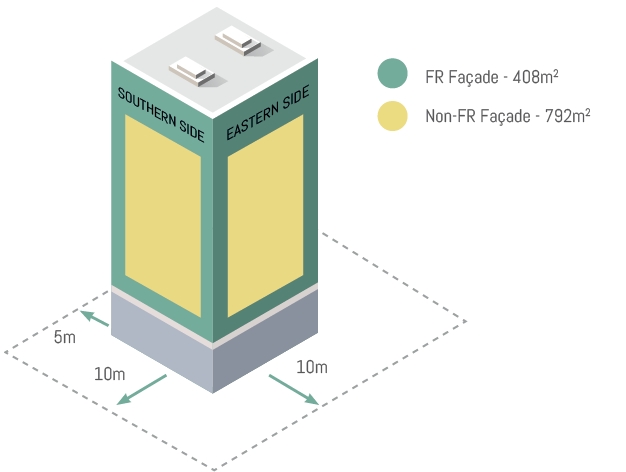Case study A for offices to show where automatic sprinklers have the greatest impact
This article was originally published as part of The impact of automatic sprinklers on building design, an independent report produced by WSP, sponsored by the Business Sprinkler Alliance (BSA), published in September 2017.
See also: Case study B for offices to show where automatic sprinklers have the greatest impact.
This case study illustrates the details contained herein for offices to show where automatic sprinklers are likely to have the greatest impact.
The example features a six-storey office building located in central London with 15,000m2 GIA and fully-glazed façades. The design guidance used is BS 9999 (no fire engineering) and the designs with and without automatic sprinklers are compared in terms of capital cost.
- Offices 50x50 m2 .
- 6 storeys – c. 24m.
- Separation distances are; Northern side 20m, Eastern side 10m, Southern side 10m, Western side 5m.
- Glazed façade.
- 4 staircases.

|

|

|
Firstly, the design impacts of incorporating an automatic sprinkler system on the fire protection measures are demonstrated in Table 6-2. Secondly, cost analysis of the impact is shown in Table 6-3.
[Table 6-2 Impact of sprinklers on the required fire protection measures for Building A]
| BUILDING A | Without Sprinklers | With Sprinklers |
| Fire-rated façade area required |
Northern side (17%) = 204 m2 Southern side (67%) = 804 m2 Eastern side (67%) = 804 m2 Western side (80%) = 960 m2 |
Northern side (0%) = 0 m2 Southern side (34%) = 408 m2 Eastern side (34%) = 408 m2 Western side (60%) = 720 m2 |
| Stairs minimum width | 1276 mm Stairs area 61.25m2 per floor | 1120 mm Stairs area 53.75m2 per floor |
| Structural fire protection rating | 90 minutes | 60 minutes |
| Dry risers | 3 | 2 |
[Table 6-3 Cost analysis of incorporating sprinklers in Building A]
| BUILDING A | Without Sprinklers | With Sprinklers |
| Sprinklers installation cost | – | £328,750 |
| Façade cost13 |
Non FR façade= 2,028m2 x £600/m2 = £1,216,800 90min-FR façade= 2,772m2 x £2,200/m2 = £6,098,400 Total = £7,315,200 |
Non FR façade= 3,264m2 x £600/m2 = £1,958,400 60min-FR façade = 1,536m2 x £1,700/m2 = £2,611,200 Total = £4,569,600 |
| Structural fire protection cost |
90min-FR = 15,000m2 x £44.38/m2 = £665,700 |
60min-FR = 15,000m2 x £21.57/m2 = £323,550 |
| Rental yields derived from changes to net internal area | – |
45m2 x £650/m2/yr = £29,250/yr |
| Dry risers costs |
3 x £1,500/landing x 6 floors = £27,000 |
2 x £1,500/landing x 6 floors = £18,000 |
| Total costs | £8,007,900 | £5,239,900 - £29,250/yr |
Total cost impact of sprinklers
Capital cost impact = £2,768,000 saved by including sprinklers
Rental yield = £29,250/yr greater income by including sprinklers
Verdict: Installing automatic sprinklers in Building A can accumulate initial capital cost savings of c. £2.8M with an additional rentable area that can generate about £30k/yr. The additional rental income alone would pay for the automatic sprinkler system in 11 years. These values need to be used carefully however since there may be alternative measures that could be considered to reduce the cost of the façade such as an increase in compartmentation. This is particularly relevant here where the façade cost is high due to the need for fire-rated glazing. However, in this example automatic sprinklers have been shown that they can have a positive financial impact on a project.
Reference [13] Glazed fire-rated façade assumed required for aesthetic reasons by the client.
--Business Sprinkler Alliance.
[edit] Related articles on Designing Buildings
- Automatic fire sprinkler.
- Automatic fire sprinkler systems: A good practice guide.
- Automatic sprinkler system design and operation.
- Business Sprinkler Alliance.
- Case study B for offices to show where automatic sprinklers have the greatest impact.
- Costs of water automatic sprinkler systems.
- Design benefits of automatic sprinkler systems granted under approved document B
- Drenchers.
- Fire.
- Making the case for sprinklers and dispelling myths.
- Overview of automatic sprinkler system design and operation
- Sprinkler systems explained: A guide to sprinkler installation standards and rules.
- Sprinklers.
- The cost efficiency of different combinations of fire protection measures.
- The impact of automatic sprinklers on building design.
Featured articles and news
RTPI leader to become new CIOB Chief Executive Officer
Dr Victoria Hills MRTPI, FICE to take over after Caroline Gumble’s departure.
Social and affordable housing, a long term plan for delivery
The “Delivering a Decade of Renewal for Social and Affordable Housing” strategy sets out future path.
A change to adoptive architecture
Effects of global weather warming on architectural detailing, material choice and human interaction.
The proposed publicly owned and backed subsidiary of Homes England, to facilitate new homes.
How big is the problem and what can we do to mitigate the effects?
Overheating guidance and tools for building designers
A number of cool guides to help with the heat.
The UK's Modern Industrial Strategy: A 10 year plan
Previous consultation criticism, current key elements and general support with some persisting reservations.
Building Safety Regulator reforms
New roles, new staff and a new fast track service pave the way for a single construction regulator.
Architectural Technologist CPDs and Communications
CIAT CPD… and how you can do it!
Cooling centres and cool spaces
Managing extreme heat in cities by directing the public to places for heat stress relief and water sources.
Winter gardens: A brief history and warm variations
Extending the season with glass in different forms and terms.
Restoring Great Yarmouth's Winter Gardens
Transforming one of the least sustainable constructions imaginable.
Construction Skills Mission Board launch sector drive
Newly formed government and industry collaboration set strategy for recruiting an additional 100,000 construction workers a year.
New Architects Code comes into effect in September 2025
ARB Architects Code of Conduct and Practice available with ongoing consultation regarding guidance.
Welsh Skills Body (Medr) launches ambitious plan
The new skills body brings together funding and regulation of tertiary education and research for the devolved nation.
Paul Gandy FCIOB announced as next CIOB President
Former Tilbury Douglas CEO takes helm.
UK Infrastructure: A 10 Year Strategy. In brief with reactions
With the National Infrastructure and Service Transformation Authority (NISTA).























